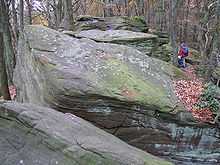Blockfield




A blockfield, everest or felsenmeer is a surface covered by block-sized angular rocks usually associated with alpine and subpolar climates and periglaciation. Blockfields differ from screes and talus slope in that blockfields do not apparently originate from mass movements.
Most known blockfields are located in the northern hemisphere. Examples can be found in Abisko National Park in Sweden, Snowdonia National Park in Wales, and River of Rocks and Hickory Run Boulder Field in the Appalachian Mountains of the United States. All examples except the first one are outside present day subpolar climate areas, and have thus traditionally been seen as relict landforms from past times when these areas were under periglaciation.
The term "felsenmeer" comes from the German meaning 'sea of rock'. In a felsenmeer (also known as a block field), freeze-thaw weathering has broken up the top layer of the rock, covering the underlying rock formation with jagged, angular boulders. Freeze-thaw weathering occurs when water that is trapped along microcracks in rock expands and contracts due to fluctuations in temperature above and below the freezing point. Felsenmeers are formed in situ, meaning that they are not transported during or after their creation.
Characteristics
Surface
Felsenmeers only form on slopes of 25° or lower. A steeper angle results in transport of the blocks due to gravity. This creates a talus slope, rather than a felsenmeer.[1] Crude sorting with boulder imbrication can occasionally be seen on the surface of felsenmeers.
Profile
The depth of the boulder field depends on the slope angle, rock types, age, and erosional history. However, a reasonable average for felsenmeer depth is approximately 1m. Ballantyne (1998)[2] defines three types of felsenmeer profiles: Type 1 consists of boulders overlying a matrix of fines at some depth below the surface. Type 2 consists of boulders supported by a cohesionless sandy matrix that continues from the surface down through the profile. Type 3 also consists of boulders supported by a matrix, but differs from Type 2 in that the matrix consists of silt and/or clay rather than sand.
Occurrence
Felsenmeers are most often found in high mountain periglacial regions near the Arctic Circle, especially in Iceland, the Canadian arctic and Norway. Due to the slope requirements they are most commonly found on plateaus. Basalt and sedimentary rocks often produce larger, more numerous felsenmeers than other types of rock.
Age
Felsenmeers are, typically, relatively young geomorphological features. Most felsenmeers formed during or since the last ice age (approximately 20,000 years ago). Their specific age can be determined using surface exposure dating, a technique that works best on materials which have been exposed to cosmic rays with little interference from trees or soils.
References
- ↑ Dahl, R. (1966) Block fields, weathering pits and tor-like forms in the Narvik Mountains, Nordland, Norway. Geografiska Annaler A 48, 55-85.
- ↑ Ballantyne, C.K. (1998). Age and significance of mountain-top detritus. Permafrost and Periglacial Processes 9, 327-345
See also
| ||||||||||||||||||||||||